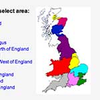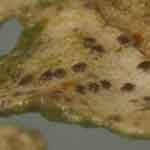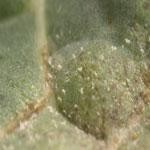This website provides an interactive crop-specific forecast of the risk to winter oilseed rape crops from light leaf spot.
The preliminary forecast is usually issued in September/October of each year. This uses previous season pod incidence data, deviation from 30 year mean summer temperature data and 30 year mean rainfall data to produce an initial regional risk forecast. The forecast is then updated again in spring to the final forecast which includes deviation of actual winter rainfall data from the 30 year mean. The forecast was updated on 10 April 2018 .
You can register to be notified by e-mail when an updated forecast is released. You can also get updates to your computer or mobile phone via twitter (@LeafSpot).
Light leaf spot forecast update notification
To be notified on updates to the Light leaf spot forecast, please enter you email address below.

Biology of the pathogen, Pyrenopeziza brassicae
The fungus (Pyrenopeziza brassicae) which causes light leaf spot is able to survive the summer months on debris from the previous oilseed rape crop and to a lesser extent on rape volunteers and vegetable brassicas.

Forecast development
The light leaf spot forecast has been developed using the Defra-funded Winter Oilseed Rape Pest and Disease Survey results. The forecast is based on crop and weather factors.
Historical trends - light leaf spot
For reference, the maps below allow a comparison of the previous three years updated average regional forecast for the percentage of crops with >25% affected plants

Recognising light leaf spot
Identification of the disease in the growing crop is difficult because symptoms are not always visible and are easily confused with other plant disorders

Regional Light Leaf Spot risk forecast
This forecast is produced with disease data from the Defra funded Oilseed Rape Pest and Disease Survey delivered through CropMonitor




